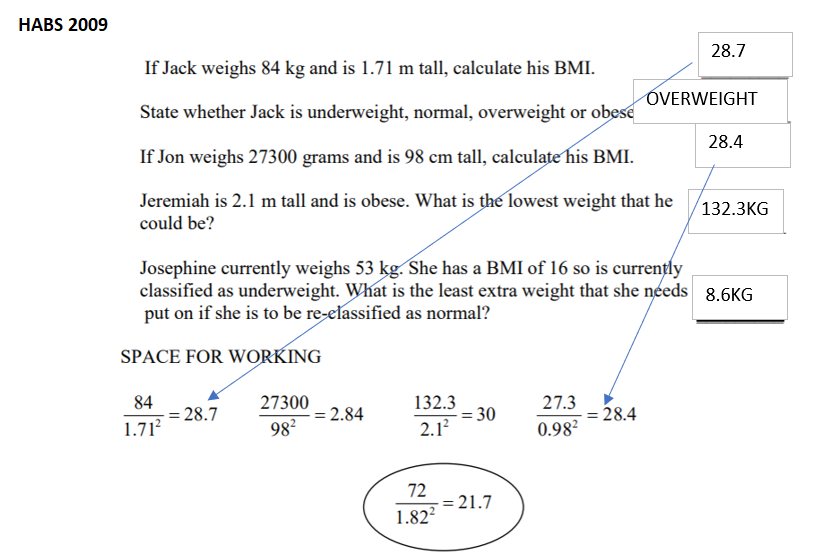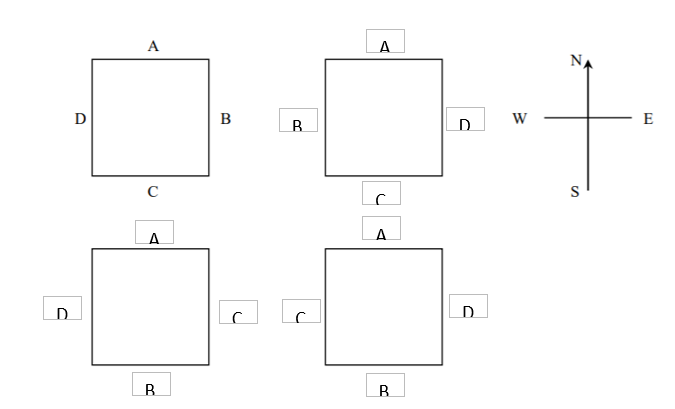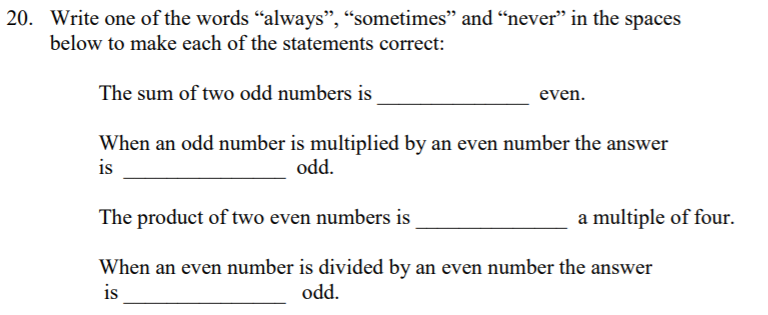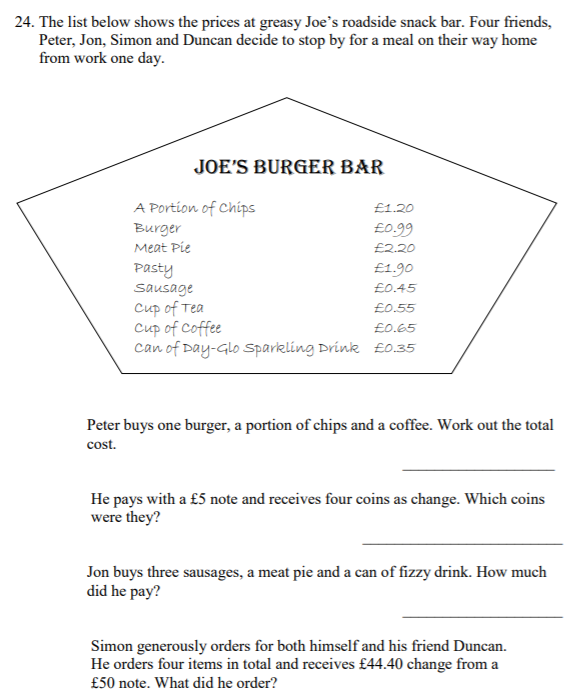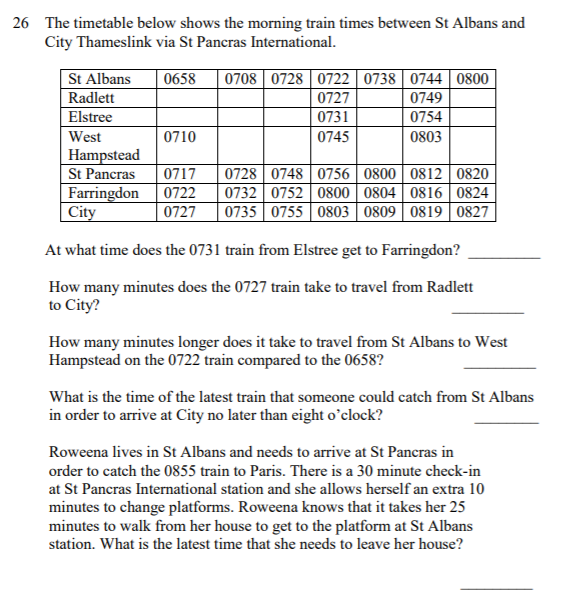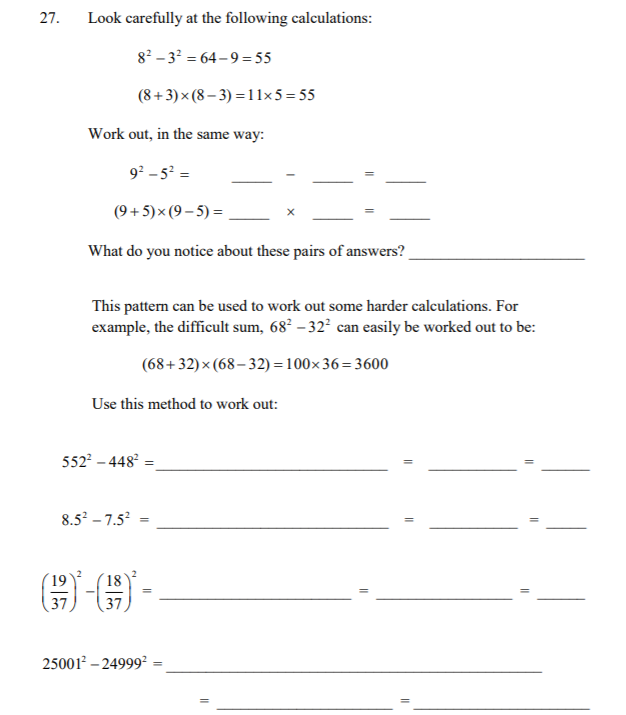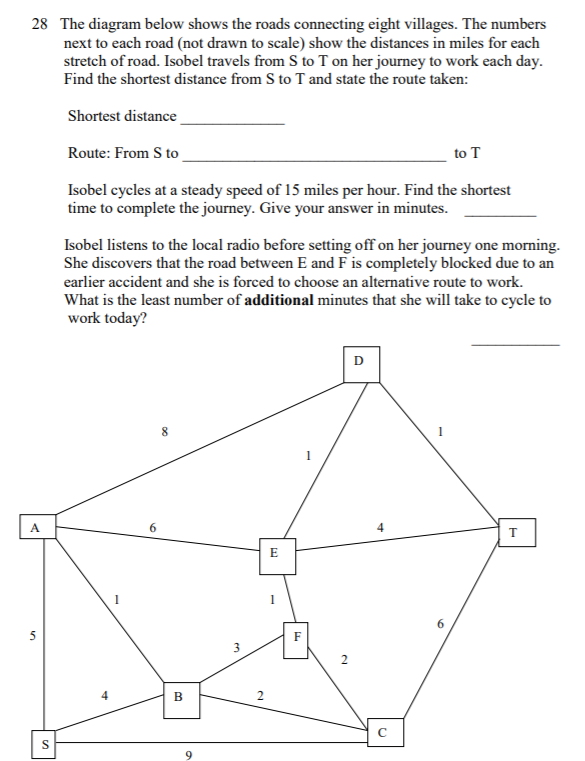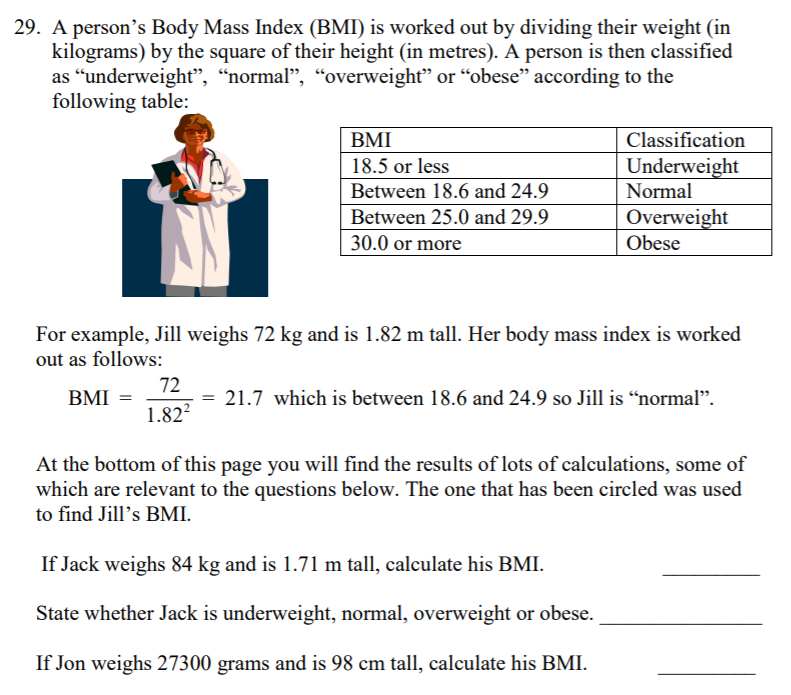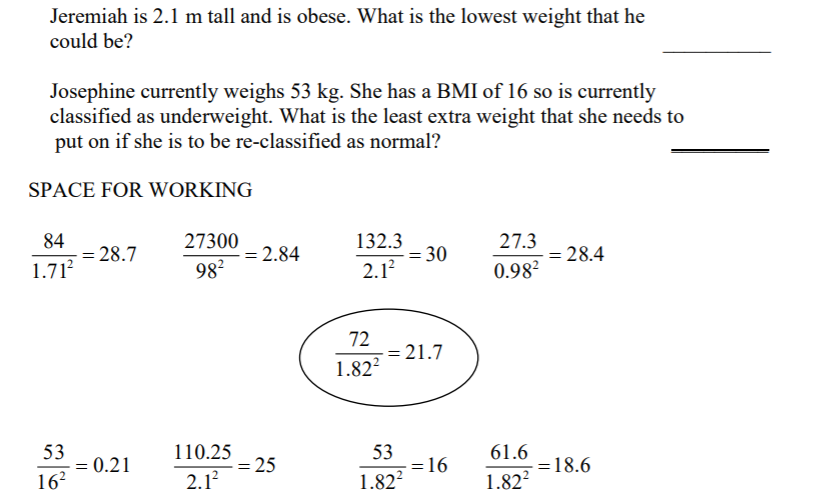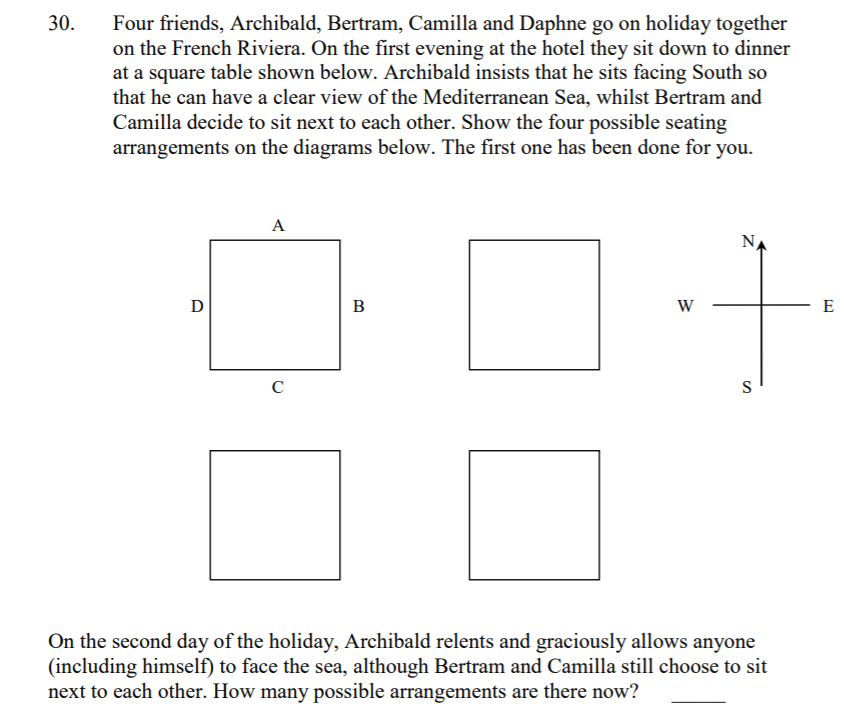121 Standard Operations Question 49 Standard Operations Question. Ensure to “borrow 1” from the 8 as you can’t do 2-3 in the Units Column 85 Standard Operations Question 36 Use Bus Stop method as the easiest approach 24 This is still difficulty 1. Its just subtraction in words 7 x 48 = 336 Standard Multiplication question…in words £11 Standard Division question. Use Bus stop method 300 Still Standard Operations but slightly harder as its 4 numbers 53,018 The trick with numbers and being able to “easily read them” is to mark a comma every 3 digits….STARTING FROM THE RIGHT HAND SIDE of the number and working RIGHT to LEFT £1.20 Can be done a few ways. Easiest way is to think of HCF of 750g and 1kg. This is 250g. Then to work out 250g cost and from there, x by 4 5/12 So this is a relatively common question for some schools. Find the LCM of the denominators 3 & 2. This is 6. Therefore, x 1/3 by 2 and 1/2 by 3 which gives 2/6 and 3/6. If this doesn’t give a fraction in between the 2 fractions, then x2 for each fraction This gives 4/12 an 6/12 This “forces” out a middle fraction of 5/12. Note: You have to have the same denominator in order to solve this question 34 With word questions like this, just start off with one sentence at a time: Many students do get confused because of the number of words and phases to this journey. However, just methodically do one sentence at a time 19 Simplest approach is to convert this to an algebra format question So, since the number is doubled, let this equal 2x 41-2x=3 Then rearrange as per normal -2x=3-41 2x=38 x=19 47.6 0.392 Standard Operations questions but just moving the decimals. Number of zeros in first qtn is 1, move 1 place to right. Number of zeros in second question being 2, move 2 places to left. Multiply, move decimal to right. Divide, move decimal to left £0 Step 1: 10% of £20 = £2 Step 2: 20% of £10 = £2 If not sure on % of an amount, use the following approach. Remember, “of” in maths means multiply So 10/100 x 20/1. Remember to cross cancel to make the fraction easier to calculate i) 10cm ii) 2 inches iii) 295cm i) Calculate number of cm per inch. So 30cm/12.5inches = 2.5cm per inch. 4 x 2.5 = 10cm ii) Work backwards now that you know its 2.5cm per inch 5cm/2.5cm per inch = 2 inches iii) cm in 9ft 10 inches 9ft = 30cm (per foot) * 9 = 270cm 10 inches = 2.5 x 10 = 25cm Total 295cm Direction you need to turn: Anticlockwise Angle of turn required: 60 degrees Like prior word based questions, just break it down 1 sentence at a time: Start at zero degrees (or think of it as 12 o’clock). 40 degrees clockwise will be to the right 70 degrees anticlockwise will take you a net 30 degrees to the left of zero 90 degrees clockwise turn from there will take you to a net 60 degrees right. So 60 degrees clockwise 5 large 13 small Total 18 crates needed. Question requires breaking down the words and going statement by statement L = 12 cartons S = 4 cartons (5 x 12) + (20 x 4) = 140 capacity To store 110, you would use all the large crates first: 78 13 x 6. always never always sometimes The above rules are worth remembering. They help when you are checking answers. For example, if you multiply 2 odd numbers in a calculation and get an odd number as your answer, you know something is wrong. So worth remembering these 12 The best way to solve this question is with the use of Algebra. In fact many maths questions where they have someone or something being “X” times more or less than the other, Algebra comes in handy. So lets solve…. 2Harsha=1Ravi 2Ravi=1Harpreet If 42 sweets altogether, then lets work out the total number of “shares” of sweets: 4Harsha+2Ravi+1Harpreet In the above, you start with Harpreet as being 1 share (or x if you like) and then work through to Harsha The objective is to get to the number of “shares” to see how many portion you divide the sweets between. Its 7 times So 42/7 means each share of sweets is worth 6. Ravi gets 2 shares so he gets 12 seven fifteen A very basic question provided students read the question. Note “words” in bold. All words in bold should be taken note of in any question i) 10am 31st January ii) 1pm 1st February Like prior questions, work through this question one step at a time. i) If its 11pm in the UK on 30th January and Australia is 11 hours ahead, then one way is to add 12 hours to 11pm and take 1 hour away. So the time in Australia will be 10am. Its then the following day there so its 31st January For number of days in the month, remember the knuckle test.! ii) Its easier to break this down into 2 phases. Start with the time in Australia when Matilda leaves the UK: She leaves at 10am 31st January. Then add on the flight time of 27 hours which will be 1 day + 3 hours So in total it will take you to 1pm on 1st February Try and do one element at a time. Students who try and add 27 hours straight onto 10am make mistakes. So breaking it down into 1 day and then separately 3 hours, makes it easier i) 1 burger £0.99 1 chips £1.20 1 coffee £0.65 Total £2.84 Do your workings neatly by aligning the columns for each digit ii) Change £5.00 – £2.84 = £2.16 4 coins therefore being £2 coin, 10p, 5p, 1p iii) 3 Sausages £1.35 (£0.45 x 3) Meat Pie £2.20 Drink can £0.35 Total £3.90 iv) £50 – £44.40 = £5.60 spent 2 Meat Pies £4.40 (£2.20 x 2). Leaving £1.20 to spend 1 Coffee £0.65 1 Tea £0.55 Total £5.60 The above is by some trial and error. It is worth adding in the larger ticket items first. ie the Meat Pies. Then understanding where that leaves you. The answer should then be clear as being 1 coffee and 1 tea These types of questions are good practice for Non Verbal Reasoning and particularly cube related shape questions which are common. i) 0800 The best way to read tables is always to read them horizontally and vertically. Use a ruler if needed to ensure no misalignment in reading ii) 36minutes Read across from 0727 Radlett until you align and then move down to the City in the same column iii) 12minutes Firstly evaluate St Albans to West Hampstead 0722 which arrives West Hampstead 0745. 23 Minutes Secondly, similar for 0658. Arrives West Hampstead 0710. 12 Minutes Work out difference iv) 0728 Work backwards. Look at last train to get to the city before 0800 which is the 0755. Then work vertically up to see time it leaves St Albans v) 01719 Work backwards again on this: 0855 train she needs to catch. Less 30 minutes check in means 0825. Less 10 minutes platform change means 0815. So the train arriving before 0815 at St Panceas is the 0812 train. She therefore needs to get the 0744 from St Albans Less the 25 minute walk means that she should leave home at 0719 Completed blanks in the following order 81-25=56 14×4=56 They are the same. (NOTE: This is a nice trick to remember). Follow the example guideline. (552+448)x(552-448) = 1000 x 104 = 104,000 (8.5+7.5)x(8.5-7.5) = 16 x 1 = 16 (19/37+18/37)x(19/37-18/37) = 37/37 x 1/37 = 1/37 (25001+24999)x(25001-24999) = 50,000 x 2 = 100,000 NOTE: The above is a great approach to remember for future questions. i) 10 miles ii) S to B to F to E to D to T The thing to note here is that the map is not drawn to scale so extra attention has to be paid to the miles between different points iii) 40 minutes Time = Distance/ Speed. So substituting into the formula, Time = 10/15 which = 2/3 of 1 Hour (10/15 x 60). So thats 40 minutes iv) 8 minutes The revised route is S-B-C-T. So an extra 2 miles This means 12/15 of 1 hour so 12/15 x 60 = 48 minutes Difference being 8 minutes a) 28.7 (per formula) b) Overweight c) 28.4 (per formula) d) 132.3kg (per formula) e) 8.6kg ( 61.6 – 53) a) 16 b) 24 (However many people there are, permutations are each number x each number. So for example if there are 3 people, possible permuations are 1x2x3 =6. For 4 people, its 1x2x3x4)

